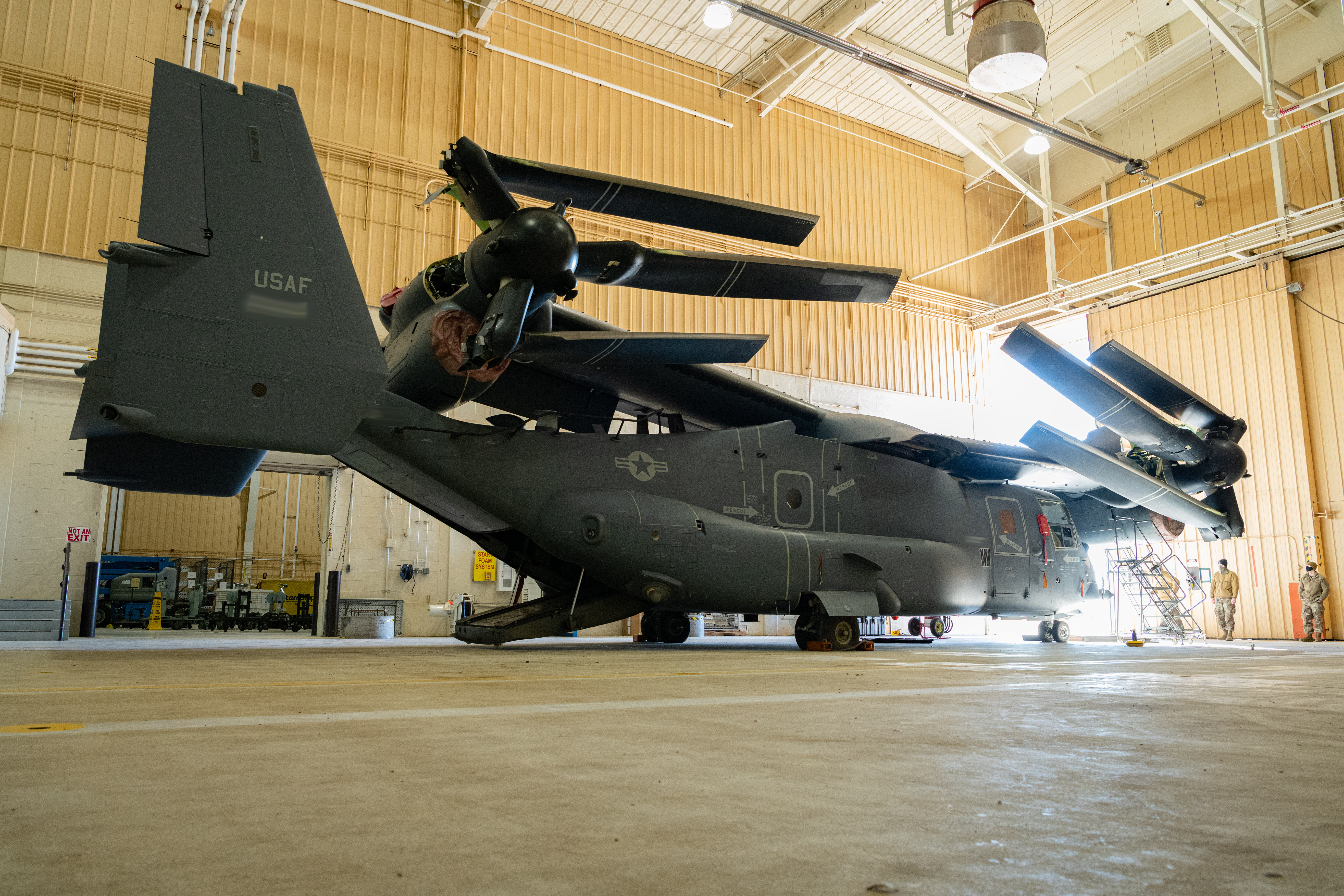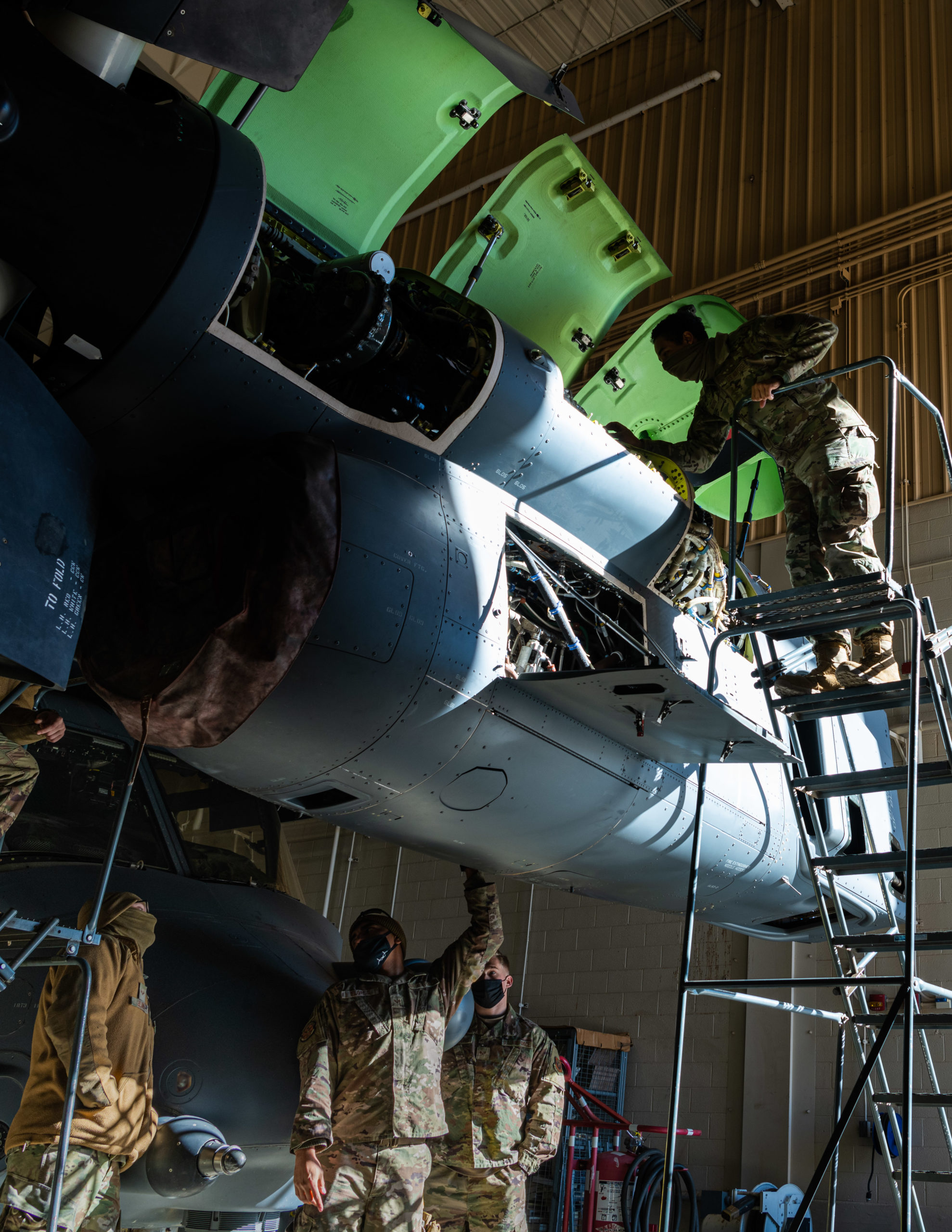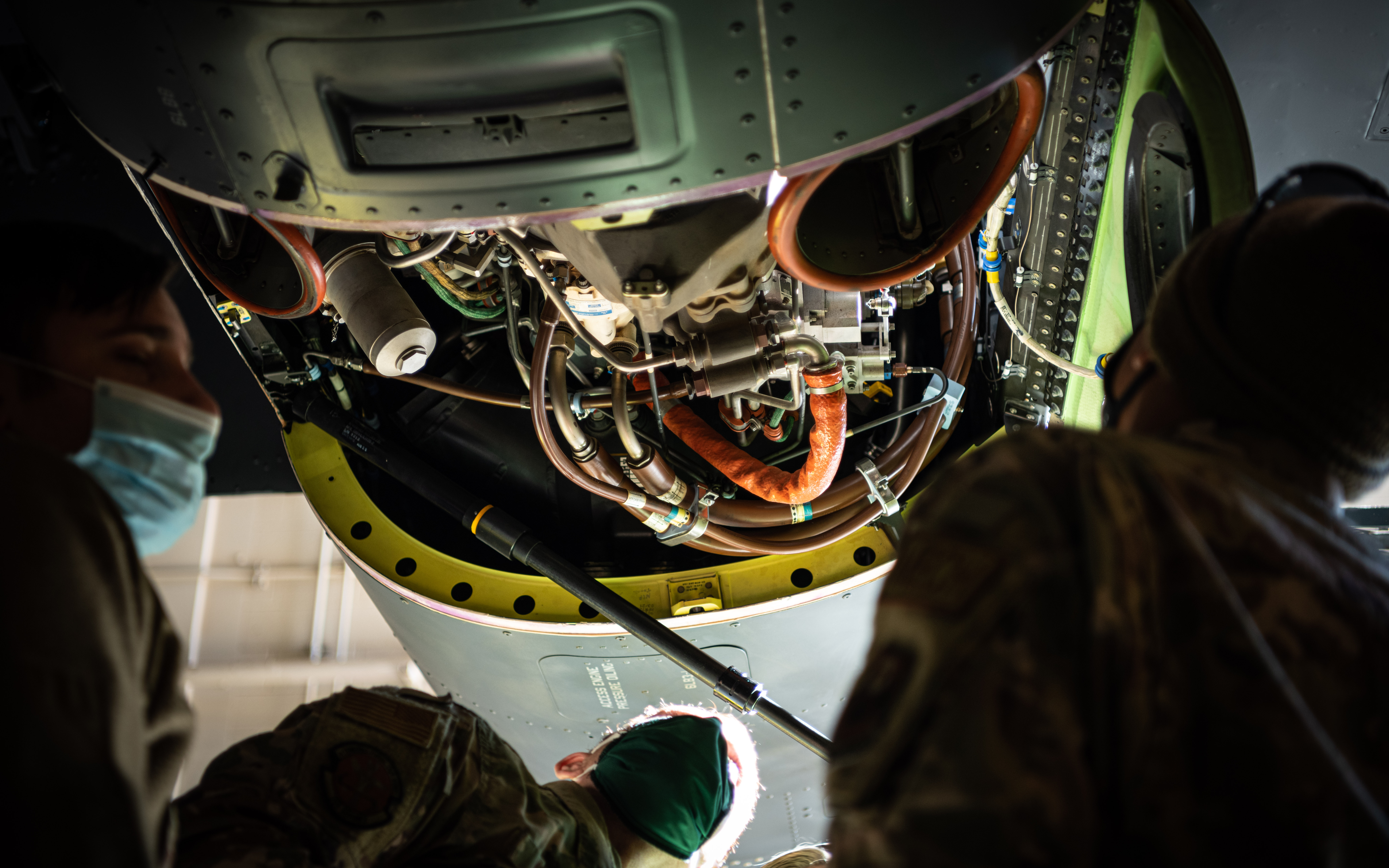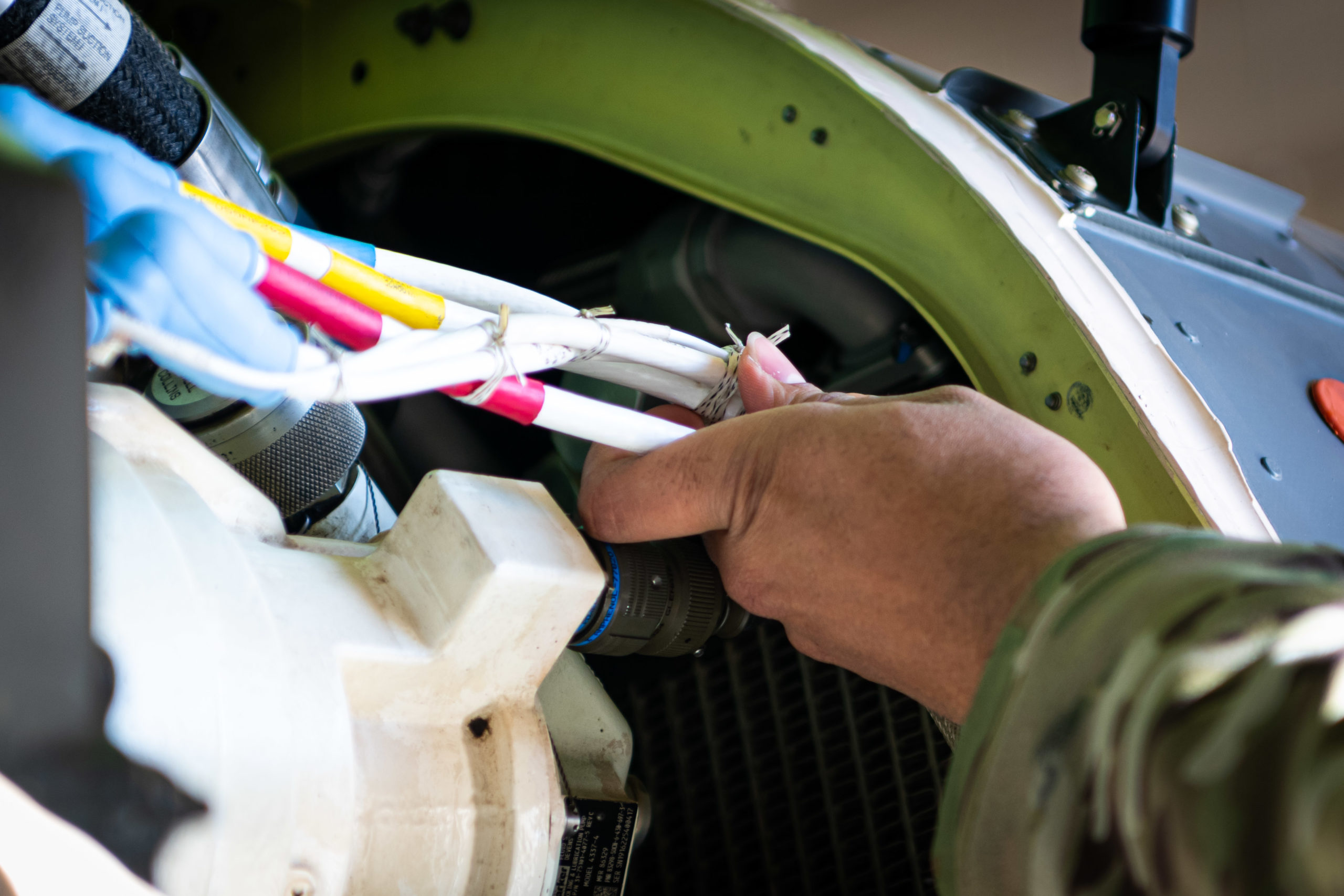According to the USAF: “U.S. Air Force Airmen assigned to the 20th Special Operations Squadron familiarize themselves with the new nacelle improvement modifications on a CV-22 Osprey tilt-rotor aircraft at Cannon Air Force Base, N.M., Jan. 7, 2022.
“The improvements should increase aircraft availability and reduce required maintenance actions, leading to increased flying hours.
“The versatility of the CV-22 offers increased speed and range over other rotary-wing aircraft, which enables the 20 SOS to conduct long-range infiltration, exfiltration and personnel recovery missions deep into enemy territory.”
This process started with the award of a contract for a major nacelle redesign effort announced by NAVAIR on January 27, 2021:
The Naval Air Systems Command awarded Bell Boeing an $81 million contract to develop, design and install nacelle modification kits and install conversion area harnesses on the CV-22 Osprey, the Air Force Special Operations Command’s (AFSOC) variant of the tiltrotor aircraft.
“This complex effort will improve both the reliability and maintainability in one of the most critical areas on the aircraft,” said Col. Matthew Kelly, V-22 Joint Program Office (PMA-275) program manager. “This contract implements the most comprehensive maintainability improvement since CV-22 fleet introduction 14 years ago; it will quickly pay readiness dividends for the fleet.”
The V-22 nacelles house the power and propulsion components of the aircraft and the conversion area includes complex wiring bundles routing from each nacelle, feeding power through various elements of the aircraft. Together, the nacelles and harnesses are crucial and complex elements, responsible for giving the V-22 its unique ability to fly vertically and horizontally.
“Approximately 60 percent of maintenance man hours are spent in the nacelles,” said Col. Brian Clifford, the PMA-275 CV-22 program manager. “By refining the design for maintainability in these areas, we will ultimately reduce repair time and improve readiness.”
The planned modifications were designed based on feedback from Air Force and Marine Corps maintainers to improve access to the nacelles.
“We wanted to make sure that the individuals actually doing the hard work, opening up the nacelles, having to replace wires and troubleshoot, reap the benefits of this program,” said MSgt Bryan Sohl, the CV-22 division superintendent.
Initial kit delivery and installs, covered in this contract, are scheduled for completion in late-2021 at Bell’s Amarillo Assembly Center in Amarillo, Texas. The Marine Corps and Navy are also looking to incorporate the nacelle and wiring improvements onto the MV-22 and CMV-22B variants.
“The team’s efforts to get this contract negotiated and awarded were exemplary; the results of this contract will have positive and significant impacts to the AFSOC CV-22 fleet,” said Clifford.
Bell noted in a September 23, 2021 press release that the first CV-22s had arrived at their plant for the nacelle modifications:
The first Air Force CV-22 Osprey designated for nacelle improvement modifications arrived at Bell’s Amarillo Assembly Center on Sept. 21. The aircraft is part of an ongoing process by Bell Textron Inc., a Textron Inc. (NYSE: TXT) company, and Boeing (NYSE: BA) (together referred to as “Bell Boeing”) to further increase the Osprey’s reliability and maintainability for the Department of Defense (DOD).
Naval Air Systems Command (NAVAIR) awarded Bell Boeing an $81 million contract in December 2020 to complete Nacelle Improvements on the CV-22 fleet. The contract covers completion of non-recurring elements, fabrication of nine kits, and installation of one kit. NAVAIR has an option period to cover fabrication and installation through 2025.
“We worked directly with our DOD partners, including servicemen and women who maintain these transformational aircraft, in development of the targeted improvements within the nacelle to increase readiness rates while driving down sustainment costs,” said Kurt Fuller, V-22 program director and Bell vice president. “Bell Boeing engineers developed innovative solutions to support fleet needs and enhance the maintainability of the V-22 using direct customer feedback.”
Approximately 60 percent of maintenance man hours are spent in the nacelles. Bell Boeing successfully engineered more than 1,300 new V-22 part numbers to help improve reliability and maintainability of the nacelles while also reducing repair time. The improvements are predicted to increase aircraft availability and reduce maintenance time.
“Tiltrotors have always brought a new level of capability to aviation,” said Shane Openshaw, V-22 deputy director and Boeing vice president. “No other aircraft can accomplish the unparalleled reach, speed, agility of the V-22, and these upgrades help ensure the Osprey remains a ready and capable aircraft for the DOD for decades to come.”
Bell Boeing works closely with the U.S. Air Force Special Operations Command and other V-22 customers to pursue upgrades, reduce maintenance, and increase reliability.
NAVAIR completed the first flight with nacelle improvements on a Marine Corps MV-22 test aircraft on April 23, 2021. The MV-22 shares the same nacelle structure as the CV-22 and allowed the Bell Boeing team to receive input from NAVAIR and fleet maintainers before the first Air Force aircraft begins modifications. Bell Boeing will perform the CV modifications in Amarillo, Texas, Fort Worth, Texas, and is expected to complete the upgrades on all CV-22 aircraft by 2025.
And in an April 14, 2021, article by Nick Adde published by NDIA, the upgrade paths for the Osprey were highlighted:
With the Osprey now well ensconced as an integral part of the inventory, work continues on current and future upgrades. Earlier this year, NAVAIR awarded an $81 million contract to develop and install modified nacelle kits and conversion harnesses for the CV-22. Situated at the end of each wing, nacelles provide housing for the plane’s key power and propulsion components. They also hold the wiring bundles that feed systems throughout the aircraft and serve the system that converts the Osprey from vertical to horizontal flight and back.
“Approximately 60 percent of maintenance man-hours are spent in the nacelles,” Air Force Col. Brian Clifford, CV-22 program manager, said in a NAVAIR press release.
Refinement of the nacelle design should reduce time spent getting repairs and improve readiness, Clifford said. The work will take place at Bell’s Amarillo, Texas, facility. The Marine Corps and Navy also are considering the same upgrade.
A number of other major sustainment issues are currently on the table, Kelly said. The older Marine aircraft are undergoing a common configuration, readiness and modernization program, which would bring systems on 2010 aircraft up to 2020 standards. The roughly 60 modifications include new mission computers, a better weather radar and scratch-resistant wind screens, he said. The handful of aircraft that have completed the process have demonstrated increases in readiness rates, as well as a decreased need for maintenance man-hours.







